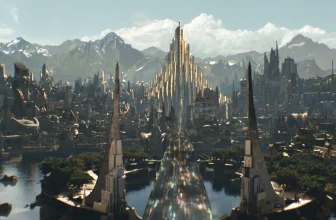Our installation is simple and direct. Four printers, customized for the pavilion’s space, draw images on desert sand, and then erase them. Every few minutes a new image replaces the previous one. Together they tell the stories of one hundred years of modernist construction in Israel. From the time of the Ottoman Empire through the British Mandate to Palestine, the visitor enters the construction site that became modern day Israel.
Before Israel was a country it was a text, inscribed in the bible and then again in Herzl’s utopian novel Altneuland (old-new land), published in 1902. The sand printers perform an act of inscription, erasure and re-inscription. Israel is an old-new invention, a modernist project grafted on the historical land. The age-old myth of a biblical legacy joins with the modern myth of new towns magically sprouting through the sand. This combination suggests a divine, ex-nihilo rebirth. Modernist construction, evident everywhere around the globe, is wholly dominant in a country the majority of which was built from 1914 to the present.

Courtesy of Roy Brand
[Theodor Herzl observing the Rhine from the balcony of Hotel Les Trois Rois during the Fifth Zionist Congress in 1901 in Basel.]
Every printer presents different historical scenarios. On the ground floor a large printer displays the whole country and the plans to populate it following the establishment of the state of Israel and the large immigration waves of the 40’s and 50’s. In 1951, Arieh Sharon, a student of the Bauhaus in Dessau, created the first master plan for the state intended to spread the population across the whole country to ‘new towns’. The plan succeeded in creating a gird of towns across the land, and failed since close to eighty percent of the population now lives in the greater Tel Aviv metropolitan area. The current National Plan curbs the desire to expend to restricted clusters of urban centers, but the same impetus continues in the occupied territories of the West Bank.

Courtesy of Roy Brand
[Poster of reconquering the land]
The anti-urbanism of the new country did strike roots and the printers upstairs show the evolution of buildings, neighborhoods, and towns as generic pattern-oriented structures that are “printed” from above according to changing ideologies and evolving master plans. We follow different dynamics. Showing how Israeli modernism evolved from a socialist driven ideology that fosters equality and transparency to a more capitalist ideology that elevates the individual family apartment or the neighborhood as autonomous units stacked on top of or alongside each other. The printer on the middle floor shows the evolution of buildings from the rectangular tenement house to the modern H structure and onto the “super H” adding individualized features such as roof porches or private gardens to the generic units.

[Image of test on sand. Evolution of building]
On the upper floor, two printers are placed side by side. The first follows the “pattern language” of new neighborhoods that pop-up quickly in pattern formation of organic or semi-orientalist structures. In certain cases, the modernist printer unconsciously “cites” a Persian carpet or an arabesque.
The second printer shows specific cases wherein the printing is preceded by wholesale erasure of pre-modern centers, surgical replacement of old structures or adaptation of different urban plans to fit the demands of modernization. Modernist dynamics of re-inscriptions here stand together with an ideology of progress that denies the past and emphasizes control, homogeneity and sanitation.
The end result is the urban-suburban mesh I call the Urburb. In the growing Urbrub environment, residential buildings dot the land with large open spaces in between. Neighborhoods spring overnight but they are locked in, dislocated and separated from the urban grid. The Urburb is a medium city built on the basis of a Kibbutz or a village plan. This hybrid manifests the conflicting demands of the modernist machine functioning in the old-new land: to create small egalitarian communities while accommodating large and diverse population, to spread-out while closing-in, and to reconnect to the land but to do so through a top-down planning system that treats the surface as a clean sheet of paper.

Courtesy of Roy Brand
[Image of urburb- Natanya]
The installation shows this not only through the data displayed but also through its performative affect. The visitor enters a modernist construction site, filled with automatic machines that sketch on sand, erase, and sketch again. Each scenario takes about three to five minutes, and every printer presents a few scenarios grouped under one theme—overplanning, evolution of buildings, pattern language, and erase and print dynamics. The whole sequence takes days to repeat. Regardless, no matter when you enter, the impression left is remarkably consistent. It is intended to convey how it feels like living within a modernist machine, under the signs of automation and the promise of an old-new beginning. In what follows I want to provide a broader historical and conceptual perspective to our mechanical installation, describing the soul locked within the machine.

Courtesy of Roy Brand
[Image of the printers, or a rendering of the installation]
The Automaton
According to Hassidic legend, King Solomon had designed an elevated throne with a mechanism that was set in motion when he claimed up and sat on it. On the first step a golden ox and a lion stretched out to support him. When seated, an eagle brought the crown and supported it over his brow. Finally, a dove brought out a Torah scroll and placed it in King Solomon’s lap.
Long before automation became useful for industry automatic devices were used for mere pleasure and entertainment. The ancient Egyptians invented sophisticated toys that moved on strings. Description of human-like robots are found in China from the 3rd century BC, and automatons where favored by the Greeks as toys, art pieces or religious devices that made matter seem animated, as if by a hidden soul.

Courtesy of www.lhup.edu
[Images of chariot]
Indeed the term automaton, first used by Homer, signifies self-movement or “acting of one’s own will”. Automatic are those material objects that seem to have the ability to think and to move. Adam might then be the first automaton, created by God from earth in his image.
The automaton then is “a thing that thinks,” or at least it gives the impression of having a will or a soul since it moves long after it was pushed, seemingly on its own. Descartes introduced this expression in his Meditations on First Philosophy published in1647. After asserting that the first foundational truth is that “I think therefore I am,” Descartes continues to elaborate:
“I am therefore precisely nothing but a thinking thing; that is a mind, or intellect, or understanding, or reason – words of whose meanings I was previously ignorant. Yet I am a true thing and am truly existing; but what kind of thing? I have said it already: a thinking thing.”
The idea that the mind should govern the body was there as early as the Greeks, but the notion of a “thinking thing” replaced the classic definition of man as a speaking animal with the more modern one that constructs the human as a “rational machine”. With modernity, the mind becomes nothing but the principle of movement that animates the machine. Its purpose is to direct, control and increase efficiency. But if the machine works all right by itself it might just be a nuisance, a disturbing ghost within the machine.
Fascination with the Machine

Courtesy of www.ablogtowatch.com
[image of “the writer”]
The “Writer” is a marvelous piece of machinery designed by Swiss-born watchmaker Pierre Jaquet-Droz in the 1770’s. It is shaped as a small barefoot boy seated next to a table holding a quill. When wound-up the boy dips his quill in the inkpot and writes a sentence of up to 40 characters. Inside the boy are 6000 different parts and 40 cams that dictate the words written. It is considered by some to be the very first analogue computer. The Writer suggests the idea that language can be rationalizes and the emotions mechanized. That is perhaps the great appeal of these automatons. They show us the world in action without human interaction; a precursor to the later modern fantasy or nightmare, which depicts our thought and action as product of elaborate set of forces, as if we too are nothing but cogs in the machine.
We cannot avoid modernism’s fascination with the machine. From photography to cinema and from smartphones to computers, we spend more time playing with machines than anything else probably. Chaplin’s Modern Times show the factory worker caught up in the wheels of the machinery, attempting and failing to adapt to the demands of industrial efficiency. Like many great modern characters, Chaplin retains something of the pre-modern world. His cinematic persona, the tramp, is dressed as an old fashioned gentleman but his walk is fragmented and jolted like a broken clock.

Courtesy of Roy Brand
[Image of Chaplin from Modern Times, feeding machine or inside the wheels]
The desire to identify with the machine becomes evident with Dada, futurism, and surrealism. These modernist movements reject, for different reasons and with different rhetoric, the conscious control of the individual for the sake of automatic production. From this perspective, Duchamp’s ready-made can be interpreted as an attempt to let art persists in the absence of an artist. His Large Glass (The Bride Stripped Bare by her Bachelors, Even), expose desire caught in a mysterious mechanical apparatus—a love machine. As in Chaplin, the movement between the bride, depicted in the upper panel, and the nine bachelors arrayed underneath, is perpetual, impossible, and arbitrary all at once.

Courtesy of Roy Brand
Artworks or buildings were rarely the result of machine manufacturing but the early modernists made every attempt to make it look as if they were. Modernist, machine-like design was seen as honest, practical and egalitarian. And the subject (the artist, worker or user) was a universal subject, everyone and anyone. If distinction was the highest value in classic times, anonymity became the aspiration of the modern. Distinction for the modern is only a matter of style. In cities and towns, distinct individuals came together, and their life cycles interlaced like rings in a chain; one desires the other desire, the desire to desire like the other.
After one hundred years of modernism, our sense perception, our bodies, our consciousness have been thoroughly reshaped by the machine. Le Corbusier‘s “Machines for Living” can refer both to his apartment houses and utopian cities as well as to the modern bodies that will inhabit them. Mechanization in modern art and architecture is both a device for blocking subjective intentions as well as means of liberation from the oppressive forces of tradition. Warhol said, “I want to be a machine” without moving a facial muscle. The thing that thinks now does so automatically.
Now, at the beginning of the twenty first century, our relationship with Modernism is complex. We are the product of this movement and we have been radically reshaped by its aesthetics. But we no longer believe in its ideology, or if we do, we no longer believe in its ability to deliver on its promise of happiness. It seems that the machine has now superseded the intention and the plan. It seems to be working by itself. The automatic structures in place are so strong and so consistent that we find it hard to imagine a different world-order. At the same time, one’s individual life, economic security, health and even personal relations seem utterly fragile and precarious. Modern life seem to amount to the impression that the world can’t change, the automatic machine keeps on going, but it is oblivious to my own personal good, or to my individual existence.
Tabula rasa
At the core of modernism stands the notion that the world must be radically reshaped. Modernism begins again, always again, from a condition of clean slate. “À la mode” means “current,” “of its times”, or the time of the new—new architecture, new art, new typography, new man and new society. There is indeed something beautiful and liberating about the sense of youthful forgetfulness of the old ways of living. Although some modern authors and thinkers revolted against the idea of the always new, always again, the effects have been accumulating and the rate of change accelerating. We now live an endless series of fragmented nows each one replaced quickly by another which is almost like it only that now, since it is not then, it’s just a bit different.
I mentioned Descartes’ thought experiment—“I think therefore I am”. This sentence, or rather proclamation, is true only to the extent that “I think” it now in the present. If I stop thinking, I might fail to exist. Thinking now verges on anxiety. I must constantly be engaged in thinking, obsessively thinking less I cease to exist.
Modernism’s rejection of the past led to a state wherein invention and repetition come together, since we are bound to repeat what we do not remember. Freud bumped into this discovery in Beyond the Pleasure Principle. Noticing that the soldiers coming back from the war return, again and again, to the situation that caused their pain. From a strictly economical viewpoint (and Freud’s psychoanalysis is a machinery that drives on the economy of pleasure) this is unexplained. Why would they return of their own free will (as automatons) to the traumatic injury? Why this obsessive re-enactment? There is no explanation for this, other than the assumption, that there must be something “beyond the pleasure principle,” which at times is called the “death drive,” an unexplainable drive that shows itself as nothing but the incessant phenomena of repetition.
Freud’s short essay from 1925, A Note Upon “The Mystic Writing Pad,” offers another explanation. The writing pad is mystic because it both retains and forgets. Just like our sand surfaces. Freud uses this as a metaphor for explaining how perception and memory work. The surface apparatus “receives perception but retains no permanent trace of them, so that it can react like a clean sheet to every new perception; while the permanent traces of the excitations which have been received are preserved in ‘mnemic systems’ lying behind the perceptual system.” Perception and consciousness are always open to new experiences while behind them the unconscious retains the traces of everything that has passed. Here Freud offers a mechanical explanation for the eternal repetition of the same that is so characteristic of traumatic injury. The pad always returns to a condition of a clean slate, but previous sketches accumulate in the background adjusting every “new” form to an overall repetitive pattern.
The Sand Clock

Courtesy of Roy Brand
[Image of sameness]
The Israeli urburb is a fortress of homogeneity and calmness or at least that is the fantasy that it installs. Almost eighty percent of the population lives in this repetitive, stuttering (urb…urb), monochromatic, generic looking, medium sized buildings separated by gardens and parking lots. Like it or not, it is the contemporary Israeli breeding ground. Over a background of past traumas and present anxieties, the middle class congregates in self-enclosed neighborhoods, both rural and city-like, cherishing its daily routine. The most common reaction to the sight of the urbrurb is that it is empty or boring. But boredom might be a psychic technique to block the possibility of an eruption. And emptiness might be the ground for creativity since the lack of external stimulation leaves room for imagination. The Israeli everydayness is haunted by the specters of a looming disaster and what looks generic is only the outward formation of vibrant and perhaps violent undercurrents.

Courtesy of Wikipedia
[Image of an hourglass as allegory of temperance]
The installation as a whole can be compared to a modern day sand clock. An allegory of temperance, it materially marks the present moment as a time in between the past and the future. Since the sand clock is turned upside down in rotation, it embodies linear progression in an endless cycle. It is both modern, representing the now in infinite progression, and the archaic, making it all present and circular. The installation holds a certain mood in suspension, making us feel how it feels like to live in these new towns without memory or unique character that pop-up as ready-mades from sand. This is life caught in everydayness; this is ordinary language architecture, which we usually miss out since it is right in front of us. Warhol’s eight hours long Empire, depicting New York’s tallest building in 1964 from evening till early morning, concerns a monumental building, but the significance is similar. We observe the non-event of time passing by. Or rather, we gaze in a reverie-like state, neither conscious nor unconscious, at the grains of sands becoming an image and then flattening out. There is something mesmerizing and sedative about our ordinary life. The promise of a redemptive time, of a new and unexpected event haunts the repetitive machine. The installation as a whole is meant to bring-out this peculiar enchantment covered by the modern everyday.
Written by: Roy Brand
Edited by: 嘉 Jia





